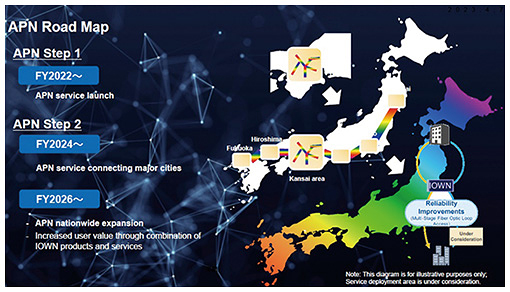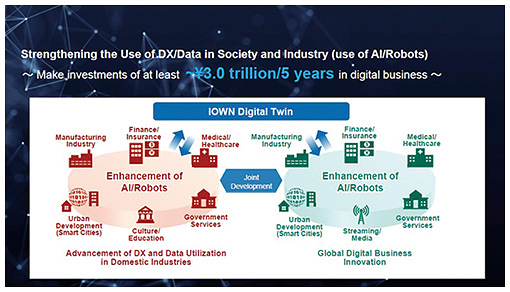 |
|||
|
|
|||
|
Feature Articles: Keynote Speeches and Workshop Lectures at Tsukuba Forum 2023 Vol. 21, No. 9, pp. 37–42, Sept. 2023. https://doi.org/10.53829/ntr202309fa5 NTT as a Creator of New Value and Accelerator of a Global Sustainable SocietyAbstractThe first commercial service of the Innovative Optical and Wireless Network (IOWN), IOWN1.0, was launched in March 2023. This article introduces its accomplishments as well as the future that will be possible with its successors IOWN2.0, 3.0, and beyond. This article is based on the keynote speech given by Katsuhiko Kawazoe, NTT senior executive vice president, at Tsukuba Forum 2023, held on May 17 and 18, 2023. Keywords: IOWN, photonics-electronics convergence, APN 1. New medium-term management strategy: IOWN-driven creation of new value (from concept to reality)The Innovative Optical and Wireless Network (IOWN)* has gained recognition since it was announced four years ago in May 2019. It is now the centerpiece of NTT’s new medium-term management strategy. “Innovating a Sustainable Future for People and Planet” is the fundamental principle of this strategy. One of its key points is being conscious of our planet. The NTT Group is not just concerned about itself; we must develop sustainable business together with everyone on Earth. When IOWN was announced, we had planned to begin service in 2030. However, after Osaka was chosen as the host city of Expo 2025, we decided to move up the schedule by five years. Nevertheless, there were still some who considered this launch as being too late, so we decided to start the IOWN commercial service this March.
2. Seeking to change the gameIn the past, Japan played a major role on the world stage when the “logic of quality” was central to business success. Quality was a key factor in creating things that provided value in the real world. The era of the “logic of numbers” then arose. This paradigm is exemplified by the Internet. Voluminous data are collected and converted to marketing data, which leads to even larger markets and spurs more collection of data. This is the world we live in, a world in which the logic of numbers is dominant. I believe what will follow next from the logic of numbers is the “logic of value.” I think it will be a time when we look back to how we as humans lived happily by mutually recognizing our diverse values and views of happiness around the world and truly respecting them. We should make it an era that is not just about numbers but our well-being. Whenever we consider what is needed technologically to achieve this, we see that photonics is its technological foundation. What we need to do is forget for the time being that all approaches are created intentionally by us humans, such as the Internet, and return once again to the basics. This is precisely the role of IOWN. We are using IOWN to achieve the next generation of communications from the fifth generation (5G) to 6G (Fig. 1).
3. From digitization for efficiency to digitization to create valueIt is often said that digitization is important. However, there are two types of digitization, digitization to improve efficiency and to create new value. Innovation that solves the problems we face and breaks through limits is difficult to achieve with digitization to improve efficiency alone. Therefore, we must also aim to achieve digitization that creates new value. The datacenter business is a critical area for the NTT Group. Data volume and power consumption are growing exponentially. The rise of general-purpose artificial intelligence (AI) and generative AI, as exemplified by ChatGPT, will accelerate these trends. Generative AI technologies such as ChatGPT have shown that they can deal with both general and specialized queries with extremely high accuracy. This is something we seriously need to be aware of because data will increase explosively (Fig. 2).
NTT has been studying optical technology and the potential of photonics for a long time. When comparing electricity and photonics, we see that they differ in the energy it takes to transmit information. When the distance from point A to point B increases, electricity naturally requires more energy than photonics to transmit information. With electricity, more energy is consumed as the operating frequency increases. However, with photonics devices there is almost no increase in power consumption. We can save energy by applying optical technology to information transmission. The Tsukuba R&D Center has become a hub for the spread of this technology around the world, and Japan leads the world in the penetration of fiber optics. NTT’s research labs have focused on the use of fiber optics in data transmission since the 1960s. Another of our goals is to also use optical technology in data processing. NTT was the first in the world to create optical transistors. The possibility of using light in data processing led to the announcement of the IOWN concept. 4. Benefits of IOWNBy reducing power consumption to 1/100 and increasing transmission capacity 125-fold compared with conventional networks, IOWN promises to make possibilities dreamt of a reality. We thus changed our policy of offering a technology after its development is complete to an approach of offering iterations each time they mature. The All-Photonics Network (APN) IOWN1.0 service was launched on March 16 this year on the basis of this new paradigm (Fig. 3).
5. Start of APN IOWN1.0 serviceThe APN is a network connected end-to-end with fiber optics. Because the network is composed entirely of optical connections, not only is low latency achieved but so is “OTN (optical transport network) Anywhere” capability, which allows latency time to be controlled by terminal equipment and the latency level to be fixed (Fig. 4).
Ahead of providing this APN service, NTT conducted several field demonstrations. Events such as musical concerts, e-sports tournaments, and live comedy shows were held to enable many users to experience the benefits of IOWN in offering entertainment services in the future. Many use cases of IOWN in the field of entertainment were introduced. The “Mirai no Ongakukai” event (“Music Concert of the Future”), held in February, demonstrated how the APN could provide low-latency content. Musicians in Tokyo and Osaka, separated by a physical distance of 700 km but connected by fiber optics, performed a live classical concert together. The latency experienced by the musicians was the same they would experience if their instruments were 3 m apart on the same stage. This experiment demonstrated that latency could be controlled using the IOWN APN, as explained above. Users of an IOWN concert application could receive the performance almost instantaneously as there is no need to buffer the content. Figure 5 illustrates the companies and organizations that are using the APN IOWN1.0 service to pioneer new businesses with NTT.
In the datacenter sector, the NTT Group currently holds the third largest market share globally. To further develop this business, we will continue our efforts to achieve carbon neutrality by 2030 using the IOWN technology. At the same time, we will continue with our efforts to reduce the energy consumed by datacenters. 6. Towards IOWN2.0 and beyondIOWN2.0 involves two areas: networks and computers. 6.1 NetworksStep 2 after the launch of the APN IOWN1.0 service is to improve power efficiency 13-fold, including for inter-prefecture communications. In Step 3, we will increase power efficiency 100-fold (Fig. 6).
From 2024, we plan to connect major cities, and from 2026, we plan to provide this connectivity as a business service to customers who need it anywhere in Japan. In combination with this service, we seek to implement “optical access network design based on concatenated loop topology” currently being developed by the Tsukuba R&D Center in the expansion of the APN. 6.2 ComputersIn June 2023, NTT will launch [launched] NTT Innovative Devices Corporation, responsible for the development, manufacture, and distribution of photonics-electronics convergence devices. This company will provide the following photonics-electronics convergence technologies that can be used not only in NTT’s own networks but also in general computers.
IOWN photonics-electronics convergence technology will change computing architecture. Computing architecture will first experience a major shift to disaggregated computing then to a memory-centric architecture. Such an architecture will become the critical foundation on which AI and robots operate. NTT plans to invest 3 trillion yen annually over the next five years to develop not only technologies that serve as the foundation of IOWN but also services, applications, and platforms that leverage IOWN (Fig. 7).
7. IOWN Global ForumThe IOWN Global Form was launched in January 2020. It currently has 120 member companies and organizations. We aim to make IOWN not just a go-to solution for datacenters but also a household name that customers can trust. We hope that IOWN will lead to a new form of economic security where Japan will once again become a major contributor on the world stage. We wish to share a grand vision in which, instead of relying on the technology of a specific country, companies around the world cooperate without the need for competition or disputes and play necessary mutual roles to establish an ecosystem together. |
|||
















